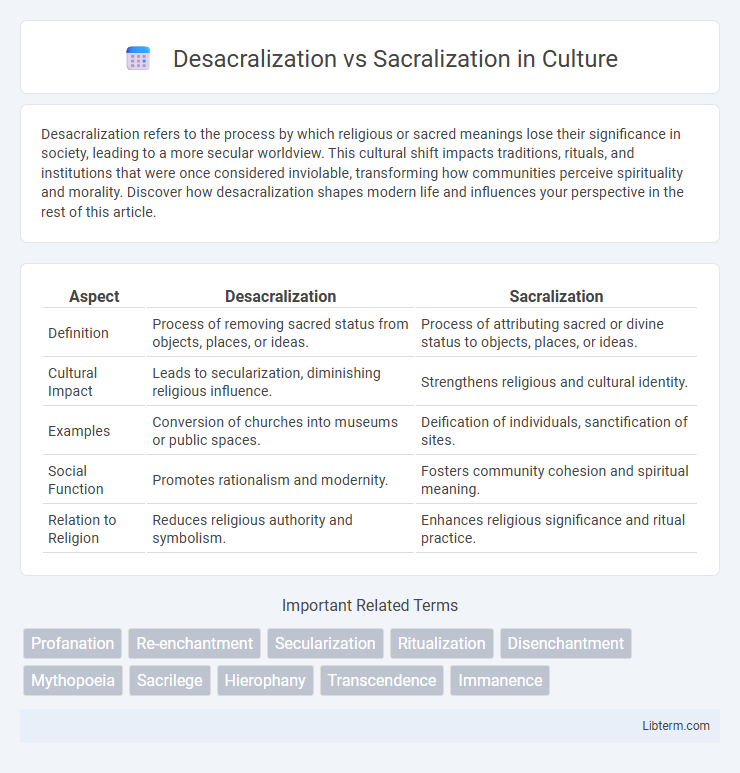Desacralization refers to the process by which religious or sacred meanings lose their significance in society, leading to a more secular worldview. This cultural shift impacts traditions, rituals, and institutions that were once considered inviolable, transforming how communities perceive spirituality and morality. Discover how desacralization shapes modern life and influences your perspective in the rest of this article.
Table of Comparison
| Aspect | Desacralization | Sacralization |
|---|---|---|
| Definition | Process of removing sacred status from objects, places, or ideas. | Process of attributing sacred or divine status to objects, places, or ideas. |
| Cultural Impact | Leads to secularization, diminishing religious influence. | Strengthens religious and cultural identity. |
| Examples | Conversion of churches into museums or public spaces. | Deification of individuals, sanctification of sites. |
| Social Function | Promotes rationalism and modernity. | Fosters community cohesion and spiritual meaning. |
| Relation to Religion | Reduces religious authority and symbolism. | Enhances religious significance and ritual practice. |
Understanding Sacralization: Definition and Origins
Sacralization refers to the process by which objects, places, or concepts are endowed with sacred significance, often rooted in religious or cultural contexts. This phenomenon originates from rituals, myths, and collective beliefs that elevate the status of certain entities to a transcendent or divine level. Understanding sacralization involves exploring how societies attribute meaning and sanctity, shaping identity and social cohesion through symbolic practices.
The Process of Desacralization in Society
The process of desacralization in society involves the gradual erosion of sacredness and religious authority over cultural symbols, rituals, and institutions, resulting in a shift toward secular values and rational worldviews. This transformation is driven by factors such as scientific advancements, modernization, and increased pluralism, which challenge traditional beliefs and reduce the influence of religion in public and private life. Consequences of desacralization include the demystification of formerly sacred domains, the rise of secular ethics, and the redefinition of meaning and identity beyond religious frameworks.
Historical Contexts: Shifts Between Sacred and Profane
Desacralization and sacralization reflect historical shifts in the perception of objects, spaces, or rituals as sacred or profane, influenced by cultural, political, and religious transformations. For example, during the Renaissance, many formerly sacred medieval sites underwent desacralization as secular humanism rose, while the Reformation led to widespread desacralization of Catholic symbols in Protestant regions. Conversely, sacralization resurges in periods of religious revival or nationalism, where artifacts or spaces regain sanctified status as a marker of identity and continuity.
Religious Institutions and Sacralization Dynamics
Religious institutions undergo sacralization as they reinforce sacred symbols, rituals, and hierarchies that foster communal identity and spiritual authority. Desacralization occurs when secular values, modernization, and rationalization diminish the perceived sacredness of these institutions, leading to reduced influence and religious practice. The dynamic interplay between sacralization and desacralization shapes how religious institutions adapt to cultural shifts and maintain relevance in contemporary society.
Secularization: The Engine of Desacralization
Secularization functions as the primary engine driving desacralization, diminishing the influence of religious sacredness in societal domains such as politics, education, and law. The process of sacralization, in contrast, involves the restoration or creation of sacred meaning within cultural or social contexts, yet it remains limited as secularization accelerates. Modernization theories highlight how secular institutions replace religious authority, promoting rationalization and scientific understanding, which collectively advance desacralization trends worldwide.
Cultural Expressions: Art, Ritual, and Sacredness
Desacralization in cultural expressions often manifests as the transformation or removal of spiritual significance from traditional art and rituals, whereby sacred symbols become secularized or commodified. In contrast, sacralization reinforces the spiritual value and reverence embedded in cultural practices, preserving the sanctity of rituals and artistic representations tied to religious or communal identity. The dynamic between desacralization and sacralization shapes how societies negotiate meaning, heritage, and identity within evolving cultural landscapes.
Politics and the Sacralization of Power
The sacralization of power in politics transforms leadership and authority into symbols imbued with sacred significance, often reinforcing legitimacy through ritual, symbolism, and emotional appeal. Desacralization challenges this by stripping political power of its mystical or divine aura, promoting secularism, rational governance, and institutional transparency. This dynamic impacts regime stability, public perception, and the balance between charismatic authority and bureaucratic rule in political systems.
Modernity and the Decline of the Sacred
Desacralization refers to the process by which modernity diminishes the influence and reverence of the sacred in social and cultural life, leading to secularization and the decline of religious authority in public spheres. Sacralization, conversely, involves efforts to reintroduce or emphasize sacred values and symbols in contemporary contexts, often as a response to the perceived loss of meaning and community in secular modern societies. The tension between desacralization and sacralization highlights the ongoing negotiation of meaning, identity, and authority amid the complexities of modernity and secularization.
Psychological Aspects of Sacralization and Desacralization
Sacralization involves the psychological process of attributing sacred meaning to objects, individuals, or rituals, which can enhance a sense of identity, purpose, and social cohesion. Desacralization occurs when these elements lose their sacred status, often leading to feelings of disorientation, loss of meaning, or existential anxiety. Understanding these dynamics is crucial in analyzing how individuals and societies adapt to cultural changes and maintain psychological well-being.
The Future of the Sacred in a Globalized World
Desacralization refers to the diminishing influence of sacred symbols, rituals, and institutions in a globalized world, where secular values and scientific rationalism dominate. Sacralization, conversely, involves the reemergence or transformation of sacred meanings within new cultural contexts, often blending traditional beliefs with global identities. The future of the sacred in globalization hinges on this dynamic interplay, shaping how communities renegotiate spiritual significance amid cross-cultural exchange and technological advancement.
Desacralization Infographic

 libterm.com
libterm.com